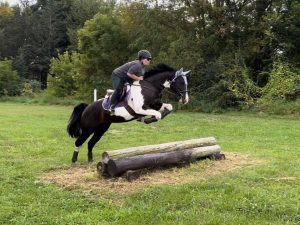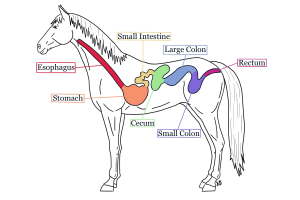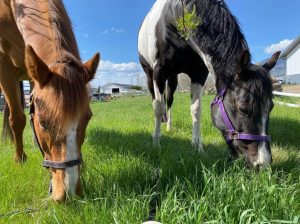36 Dazzling Digesting Dory
Sidney Geistfeld; Jennifer Nichols; and Katherine Strohm
Dazzling Digesting Dory
Why do horses eat grass and why don’t we?
Have you ever wondered why you can’t eat grass but some animals can?
Learning Objectives
- Understand the importance of fiber breakdown and how it happens
- Explain how food travels through the digestive system of a horse
- Categorize the types of fiber horses required
- Discuss the surface of horse teeth and explain how they are used to break down food
Throughout the lesson, click the audio files below if you would like to listen to the text.
Meet Dazzling Dory:

Dory is a 13-year-old paint horse. She loves competitive show jumping with her owner. But she also has another very important job – digesting fiber to keep her healthy and give her the energy her body needs to compete!
Introduction to the Digestive System of a Horse

Horses use their lips to grab hay and grass which brings the food into their mouth. The horse then uses its hypsodont teeth to grind the food. Hypsodont teeth mean that they continuously grow throughout the horse’s life. Their teeth have an uneven surface which they use to grind their food down into smaller pieces. Watch Dory use her teeth to chew:
video of a horse chewing (video by Katherine Strohm)
After the horse chews the food they swallow it. The chewed up food goes down the esophagus into the stomach. Horses have a small simple stomach that they use to start to digest proteins in their diet. There are many acidic enzymes in the horse’s stomach that help break down food. Have you ever tried a lemon? That sour taste is from the acidity of the lemon! Horses’ stomach enzymes are even more acidic than that!
The partially broken down food will then pass through the stomach into the small intestine. In the small intestine the proteins, fats, and simple sugars are further broken down and absorbed into the body. Simple sugars are like the sugar you get when you eat candy!
The rest of the fiber (hay and grass) passes through the digestive system into the large intestine. The large intestine is made up of a cecum and colon. The cecum is very large in a horse and this makes them hind gut fermenters. A human’s cecum is very small in comparison. The large intestine has microbes which are like little bacteria that help to digest the food. The chewed up food slowly moves backward and forward in the large intestine. This back and forth movement helps break down the hay and grass a horse eats. This is the fiber in a horse’s diet and we will learn more about it in the next section. After the horse absorbs all the possible nutrients it can, it will then poop out all the waste products.
What foods do horses eat?
Horses are grazing herbivores. This means they mainly eat grass and hay which are types of forages. Hay is cut and dried grass that horses can eat in the winter when there isn’t any grass available! Since horses have small simple stomachs they need to constantly eat small meals of hay throughout the day. Horses can also be supplemented with other types of forages such as hay cubes or pellets. They eat all parts of grasses including the stems, leaves and stalks. Horses are also fed grains, especially when they are young and growing so they need lots of extra nutrients to grow big and strong! This is exactly like how you need to drink milk and eat your vegetables to grow big and strong! Horses are also fed grains when they work hard (like an athlete) or get older and need extra nutrients. These grains can include corn, wheat, rye, millet, oats, barley, beet pulp, fat supplements, and proteins. Finally, it’s very important for horses to drink lots of fresh water! They drink 8-16 gallons of water a day! Could you imagine drinking 8-16 gallons of milk in a day? Fun fact: Horses can also eat treats like carrots and apples!
Check your understanding below by sorting the images into horse food and non-horse food categories!
(image credits for activity: Socks: “Socks” by cakersandco is licensed under CC BY 2.0; Grass: “I see grass of green” by chriscom is licensed under CC BY-SA 2.0; Beet Pulp: “Beet pulp pellets” by Tom Magliery is licensed under CC-BY-NC-SA 2.0; Pizza: “Pizza” by ZTurtleMan is licensed under CC BY-SA 2.0; T-Shirt: “Blue Tshirt” by Camisetas is licensed under CC BY-SA 3.0; Hay Bale: “hay bale” by Carsten Tolkmit is licensed under CC BY-SA 2.0)
What is fiber and why is it important?
Almost 100% of a horse’s diet should come from forage (hay and grass) and only a small percentage should be from grain. Fiber is a carbohydrate found in plants such as hay, grasses, and beet pulp. It provides around 70% of a horse’s energy. Fun fact: humans can’t digest fiber! However, nutrients like fiber are very important for a horse’s health, wellbeing, and performance. Check out this video of Dory! Fiber in her diet gives her energy to run and play with her friends.
video of a horse running (video by Katherine Strohm)
There are two types of fiber: soluble and insoluble. Horses require both types of fiber in their diet to maintain healthy and happy guts. Soluble fiber is the kind found in grains such as beet pulp and can be broken down and absorbed in the stomach. Insoluble fiber is a type of structural carbohydrate and has cellulose in it which has to be broken down in a horse’s large intestine. Horses have special microbes (bacteria) in their large intestine to break down the fiber.
What happens when a horse doesn’t get enough fiber?
Colic→ Horses can get abdominal pain when there isn’t enough fiber or they don’t get enough water in their diet. They will often seem upset, in pain, and may lie down.
Ulcers→ When a horse eats fiber it enters the stomach and helps act as a barrier from the acidic stomach acid. When there isn’t enough fiber in the diet, the horse doesn’t have that protective barrier. Saliva (spit) is also made by chewing a lot which horses do when they are trying to break down hay. This helps prevent ulcers from forming. Horses with ulcers may not want to eat food or have their belly touched, and they may stand in strange positions trying to get comfortable.
Strange behaviors→ Since horses are grazing animals they are used to spending the majority of their day eating food. Fiber in hay causes horses to chew a lot and eat small amounts at a time. When they don’t have hay available horses can get bored and do things they shouldn’t. They can chew on wooden fences or stall doors, or weave their head back and forth.
Dental Problems → Horses require fiber to properly gain the necessary nutrients. Because hypsodont teeth continuously grow, their uneven surfaces can become sharp and dig into the tongue or cheeks. This can become extremely painful for the horse making them not want to eat and lose weight.
Let’s test our knowledge about fiber-deficient diets below! Drag the images on the right to the corresponding labels on the left. Hint: use your mouse to hover over each image for a description.
(image credits for activity: “sad horse in pain lying down” by Sidney Geistfeld; “horse biting fence” by Katherine Strohm and Sidney Geistfeld; “diagram of stomach with a break in its lining” by Sidney Geistfeld; “Equine Overbite 2” by VetMoves.com is licensed under CC BY 2.0)
Check Your Understanding Assessments!

Dory has eaten a full meal with her friend and now it’s time to digest. Drag and drop the terms into the correct boxes as her food moves through her digestive tract.
Finally, answer the questions below to check your knowledge!
(image credits for activity: “Goldie and Friend” by Jennifer Nichols”)
Further Exploration
Here are a couple of great YouTube videos that explain how food travels through the horse’s digestive system:
nutrient in plants that the body cannot digest
a dental pattern characterized by teeth with high crowns, providing extra material for wear and tear
molecules primarily composed of carbon, hydrogen, and oxygen, and are a key source of energy for the body
a type of dietary fiber that does dissolve in water

